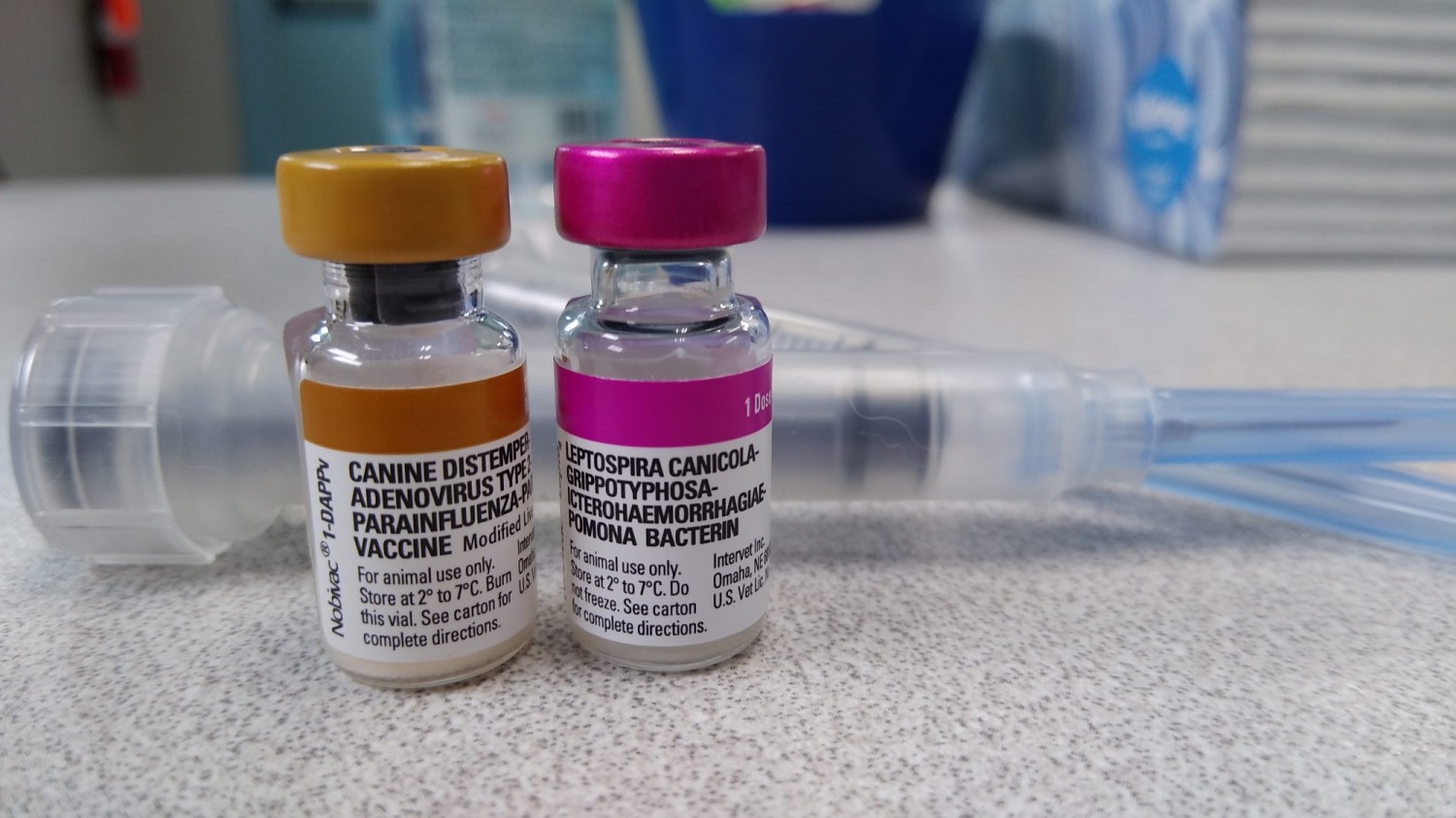My Dog Needs His “Distemperment ” Vaccine!
Adding a new pet to your family can be a wonderful and confusing experience for many people. Here you have this squirming bundle of furry joy already stealing your heart one kiss or snuggle at a time but then comes the not-so-fun decisions of health care and vaccines. What food should they eat? How should I potty train them? What about doggie school? What the heck is that vaccine that they need? Distemper something or another. Does this have to do with their temperament? Someone explained it to me once but all I heard was blah, blah, blah.. your dog needs them every so often…make an appointment with your veterinarian.
Well, here is a basic rundown of our hospital’s core canine vaccine, the distemper combination (DHPP or DHPPL depending on your pet’s needs). This basic but important vaccine is started at 8 weeks of age and boosted every 3-4 weeks until 16-20 weeks old. The vaccines are given in a series because a puppy’s immune system is ever changing and some early vaccines are not completely protective thanks to their mother’s antibodies. This is why a young dog who has had one vaccine can still become infected with diseases such as parvovirus. As an adult, the distemper combination is boosted at 12 months old and then every 3 years. There are other vaccines available such as the rabies vaccine (required by law), kennel cough, canine flu, and lyme , but we are not going to focus on those today.
Making Sense of the Vaccine Alphabet Soup
D- Distemper: This is a highly contagious virus that effects the respiratory, digestive, and nervous systems of dogs. Puppies and dogs are most likely infected through air born exposure and environmental exposure such as shared food and water bowls. The virus virus can be shed for months from infected animals.
Symptoms Include: Fever, eye and nasal discharge, coughing, lethargy, vomiting, neurological changes such as circling, seizures, and other neurological behavior.
Treatment: Supportive care. There is no cure and often times this virus is highly fatal. Permanent neurological changes may be present for those dogs that do survive the virus.
H- Canine Hepatitis or Adenovirus: This one is a bit confusing! There is adenovirus type 1 which is infectious hepatitis and adenovirus type 2 which is a component infectious tracheobronchitis (one of the many causes of the generic term kennel cough). Infection is spread directly from dog to dog or through infected urine or feces.
Symptoms Include: adenovirus 1- Fever, abdominal pain, vomiting, diarrhea
adenovirus 2- Dry hacking cough, retching, conjunctivitis
Treatment: Supportive care from isolation to prevent spreading and antibiotics to full hospitalization with IV fluids and nutritional support.
 P- Parvovirus (canine, not the human one): Parvo is one of the more common viruses that we see in unvaccinated dogs and is spread by dog to dog contact as well as contact with contaminated feces. This is a highly contagious virus that can live in the environment for six months or more and can be unknowingly spread by people on their shoes and clothes. P- Parvovirus (canine, not the human one): Parvo is one of the more common viruses that we see in unvaccinated dogs and is spread by dog to dog contact as well as contact with contaminated feces. This is a highly contagious virus that can live in the environment for six months or more and can be unknowingly spread by people on their shoes and clothes.
Symptoms Include: Lethargy, loss of appetite, vomiting, diarrhea, fever or low body temperature
Treatment: Most dogs need aggressive supportive care. This means hospitalization with IV fluids, antibiotics, and other supportive therapy to keep the body hydrated and managing GI symptoms. Even with the best care, this virus can be fatal to many that are infected, especially the youngest puppies. When recovered dogs are released home they will continue to shed the virus and infect their environment for up to six weeks.
P- Parainflunza: This is one of the many pathogens that can cause infectious tracheobronchitis (kennel cough). Parainfluenza may have similar signs and symptoms as canine influenza, but they are not the same and therefore are covered by different vaccines. Transmission is air born through the respiratory tract.
Symptoms Include: Dry or moist cough, low grade fever, nasal discharge, lethargy, and loss of appetite
Treatment: Isolation to avoid spreading and antibiotics in most cases
L- Leptospirosis: This disease is actually spread by a pathogenic bacteria that can be found world wide in soil and water. Leptospirosis can infect both animal and people. Cross infection from pets can be a concern though most human infections are from water sources such as ponds. Like people, the majority of dogs become infected by drinking from contaminated water sources (puddles, streams, lakes that have wild life exposure). Once an animal or person is infected, the bacteria are shed in the urine or infected tissues. Anywhere a sick wild or domesticated animal urinates can be a source of infection for others.
Symptoms Include: Mild transient symptoms for some, fever, muscle tenderness, increased thirst and urination, dehydration, vomiting, diarrhea, kidney failure, liver failure
Treatment: Hospitalization with aggressive supportive care and antibiotics.
Now that you hopefully have a better understanding of the value of the distemper combination vaccine, the next step is keeping your pets up to date on their protection. Your veterinarian can help to make a wellness plan that is right for the needs of your dog that should include some of the other vaccines that were mentioned earlier such as the rabies vaccine. By keeping our animal companions well protected with their vaccines, we can reduce the spread of some of these viruses and pathogens in our neighborhoods.
Interesting Fact:
The origin of the word distemper is from the Middle English distemperen, meaning “to upset the balance of the humors,” which is originally from the Latin dis- and Latin temperare, meaning “to not mix properly.” The disease, canine distemper, is sometimes called “hardpad disease” in canines due to the hardening of the footpads and nose that can be occur in infected dogs.
|